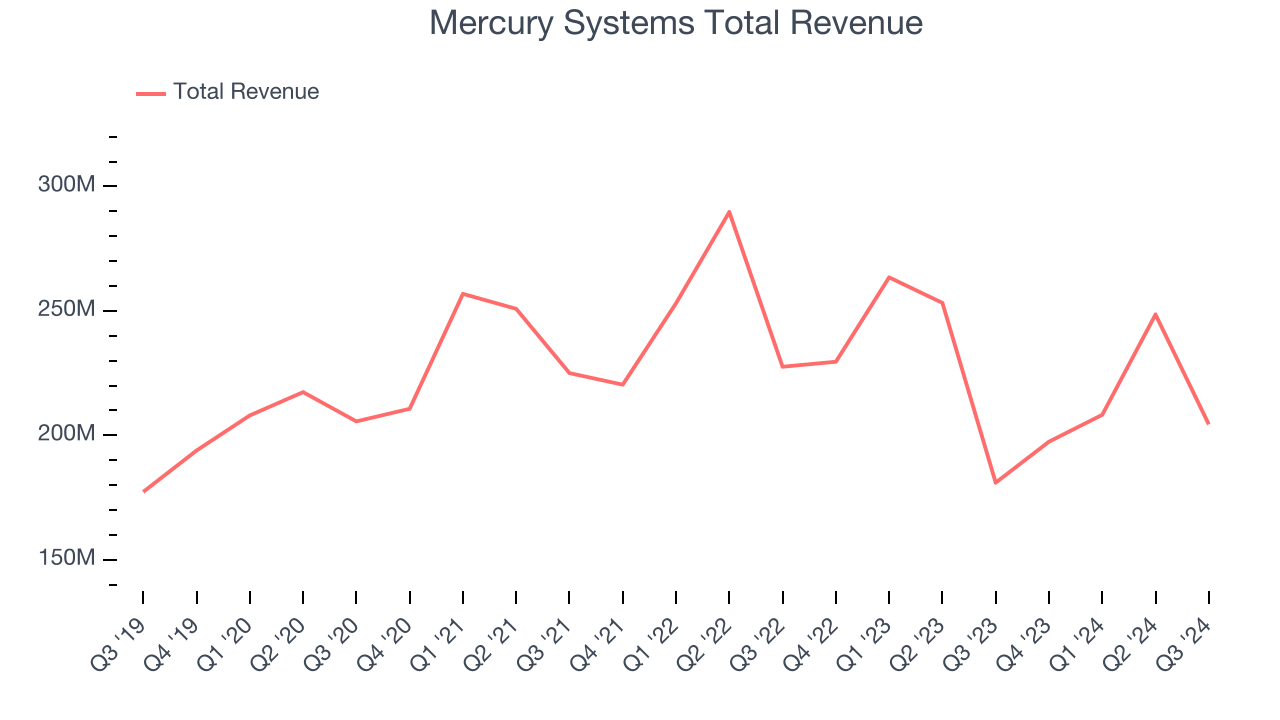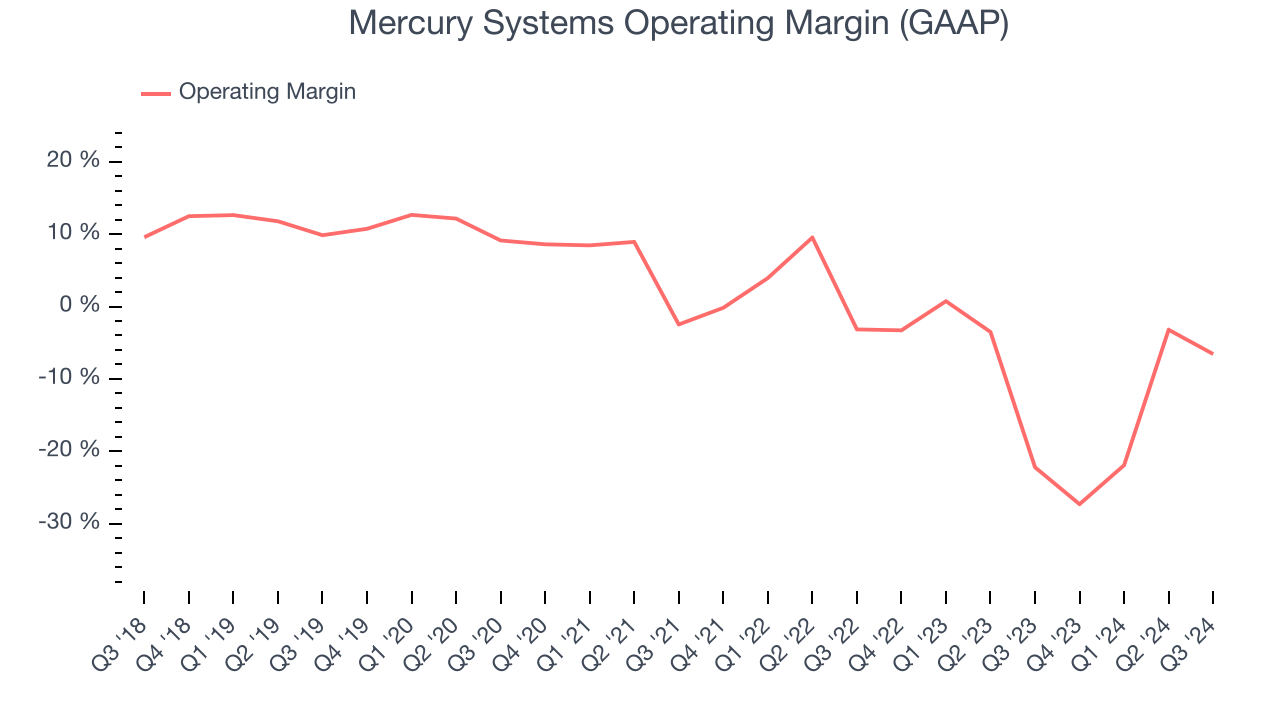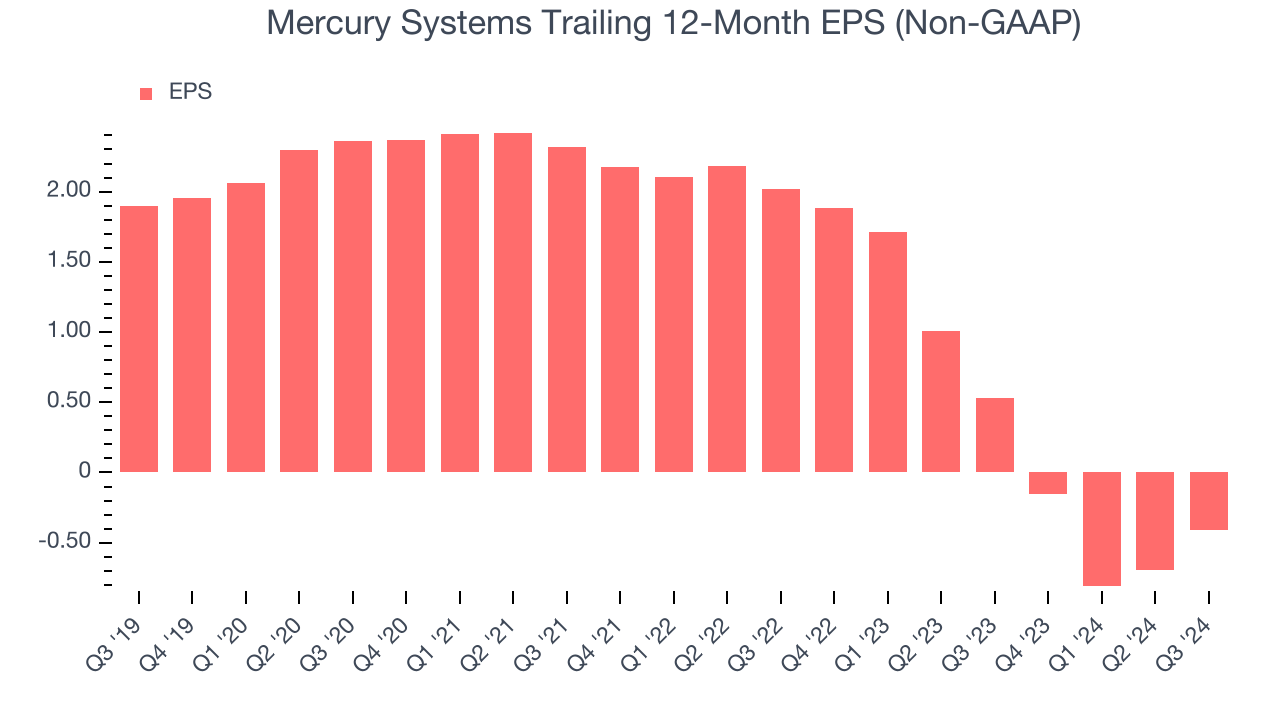
Aerospace and defense company Mercury Systems (NASDAQ:MRCY) reported Q3 CY2024 results beating Wall Street’s revenue expectations, with sales up 13% year on year to $204.4 million. Its non-GAAP profit of $0.04 per share was also 150% above analysts’ consensus estimates.
Is now the time to buy Mercury Systems? Find out by accessing our full research report, it’s free.
Mercury Systems (MRCY) Q3 CY2024 Highlights:
- Revenue: $204.4 million vs analyst estimates of $181.8 million (12.5% beat)
- Adjusted EPS: $0.04 vs analyst estimates of -$0.08 ($0.12 beat)
- EBITDA: $21.45 million vs analyst estimates of $12.59 million (large beat)
- Gross Margin (GAAP): 25.3%, down from 27.9% in the same quarter last year
- Operating Margin: -6.6%, up from -22.2% in the same quarter last year
- EBITDA Margin: 10.5%, up from 1.1% in the same quarter last year
- Free Cash Flow was -$20.9 million compared to -$47.08 million in the same quarter last year
- Backlog: $1.34 billion at quarter end
- Market Capitalization: $1.98 billion
“Our first quarter 2025 results were generally as expected, and I am optimistic about our strategic positioning and expectations to deliver predictable organic growth with expanding margins and robust free cash flow,” said Bill Ballhaus, Mercury’s Chairman and CEO.
Company Overview
Founded in 1981, Mercury Systems (NASDAQ:MRCY) specializes in providing processing subsystems and components for primarily defense applications.
Defense Contractors
Defense contractors typically require technical expertise and government clearance. Companies in this sector can also enjoy long-term contracts with government bodies, leading to more predictable revenues. Combined, these factors create high barriers to entry and can lead to limited competition. Lately, geopolitical tensions–whether it be Russia’s invasion of Ukraine or China’s aggression towards Taiwan–highlight the need for defense spending. On the other hand, demand for these products can ebb and flow with defense budgets and even who is president, as different administrations can have vastly different ideas of how to allocate federal funds.
Sales Growth
A company’s long-term performance can give signals about its business quality. Even a bad business can shine for one or two quarters, but a top-tier one grows for years. Regrettably, Mercury Systems’s sales grew at a tepid 4.5% compounded annual growth rate over the last five years. This shows it failed to expand in any major way, a rough starting point for our analysis.

We at StockStory place the most emphasis on long-term growth, but within industrials, a half-decade historical view may miss cycles, industry trends, or a company capitalizing on catalysts such as a new contract win or a successful product line. Mercury Systems’s history shows it grew in the past but relinquished its gains over the last two years, as its revenue fell by 6.9% annually. 
This quarter, Mercury Systems reported year-on-year revenue growth of 13%, and its $204.4 million of revenue exceeded Wall Street’s estimates by 12.5%.
Looking ahead, sell-side analysts expect revenue to remain flat over the next 12 months, an improvement versus the last two years. Although this projection indicates the market thinks its newer products and services will spur better performance, it is still below the sector average.
Today’s young investors won’t have read the timeless lessons in Gorilla Game: Picking Winners In High Technology because it was written more than 20 years ago when Microsoft and Apple were first establishing their supremacy. But if we apply the same principles, then enterprise software stocks leveraging their own generative AI capabilities may well be the Gorillas of the future. So, in that spirit, we are excited to present our Special Free Report on a profitable, fast-growing enterprise software stock that is already riding the automation wave and looking to catch the generative AI next.
Operating Margin
Mercury Systems was roughly breakeven when averaging the last five years of quarterly operating profits, inadequate for an industrials business.
Analyzing the trend in its profitability, Mercury Systems’s annual operating margin decreased by 25.3 percentage points over the last five years. The company’s performance was poor no matter how you look at it. It shows operating expenses were rising and it couldn’t pass those costs onto its customers.

In Q3, Mercury Systems generated an operating profit margin of negative 6.6%, up 15.6 percentage points year on year. This increase was a welcome development and shows it was recently more efficient because its expenses grew slower than its revenue.
Earnings Per Share
We track the long-term change in earnings per share (EPS) for the same reason as long-term revenue growth. Compared to revenue, however, EPS highlights whether a company’s growth was profitable.
Sadly for Mercury Systems, its EPS declined by 17.3% annually over the last five years while its revenue grew by 4.5%. This tells us the company became less profitable on a per-share basis as it expanded.

Diving into the nuances of Mercury Systems’s earnings can give us a better understanding of its performance. As we mentioned earlier, Mercury Systems’s operating margin improved this quarter but declined by 25.3 percentage points over the last five years. Its share count also grew by 5.8%, meaning the company not only became less efficient with its operating expenses but also diluted its shareholders. 
Like with revenue, we analyze EPS over a more recent period because it can give insight into an emerging theme or development for the business.
For Mercury Systems, its two-year annual EPS declines of 48.5% show it’s continued to underperform. These results were bad no matter how you slice the data.In Q3, Mercury Systems reported EPS at $0.04, up from negative $0.24 in the same quarter last year. This print easily cleared analysts’ estimates, and shareholders should be content with the results. Over the next 12 months, Wall Street is optimistic. Analysts forecast Mercury Systems’s full-year EPS of negative $0.41 will reach break even.
Key Takeaways from Mercury Systems’s Q3 Results
We were impressed by how significantly Mercury Systems blew past analysts’ EPS expectations this quarter. We were also excited its EBITDA outperformed Wall Street’s estimates. Zooming out, we think this was a good quarter with some key areas of upside. The stock traded up 2.2% to $35.02 immediately after reporting.
Mercury Systems had an encouraging quarter, but one earnings result doesn’t necessarily make the stock a buy. Let’s see if this is a good investment. We think that the latest quarter is only one piece of the longer-term business quality puzzle. Quality, when combined with valuation, can help determine if the stock is a buy. We cover that in our actionable full research report which you can read here, it’s free.













